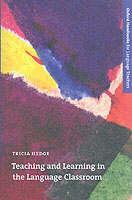Description
Teaching and Learning in the Language Classroom
A guide to current ideas about the theory and practice of English language teaching
Author: Hedge Tricia
Language: English
Subject for Teaching and Learning in the Language Classroom:
Publication date: 01-2000
464 p. · 16.5x24.6 cm · Paperback
464 p. · 16.5x24.6 cm · Paperback
Description
/li>Contents
/li>Comment
/li>
This book gives teachers a thorough grounding in current ideas about the theory and practice of English language teaching. However much experience you have as a teacher, it can help you to develop professionally. It does this by encouraging you to think about the many possibilities and challenges that ELT methodology presents, and then apply these insights to your own teaching.
Acknowledgements. Introduction.PART ONE: A framework for teaching and learning. 1. Learners and learning, classrooms and contexts. 1.1 Introduction: issues for the language teacher.1.2 What do we know about how languages are learned?. 1.2.1 The nature of input. 1.2.2 The process of intake. 1.2.3 The role of interaction in the classroom. 1.2.4 The role of error. 1.3 How do differences among learners affect learning processes and teaching procedures?. 1.3.1 Aptitude. 1.3.2 Learning style and learning strategies. 1.3.3 Affective factors. 1.3.4 Motivation for learning English. 1.4 What factors of context should teachers take into account?. 1.5 What roles can teachers and learners play in the learning process?. 1.5.1 The teacher's roles and responsibilities. 1.5.2 The learner's roles and responsibilities. 1.6 What roles can learning materials play?. 1.7 Conclusion.Discussion topics and projects.Further reading. 2. The communicative classroom. 2.1 Introduction: the concept of communicative language ability. 2.2 What are the components of communicative language ability?. 2.2.1 Linguistic competence. 2.2.2 Pragmatic competence. 2.2.3 Discourse competence. 2.2.4 Strategic competence. 2.2.5 Fluency. 2.3 What are the issues for the communicative curriculum?. 2.4 What are the implications for the communicative classroom?. 2.4.1 What are communicative tasks and what are their roles in teaching and learning?. 2.4.2 How can we manage a communicative classroom?. 2.4.3 What does communicative language teaching imply for authenticity in the classroom?. 2.5 What are the issues in applying a communicative approach in context?. 2.6 Conclusion.Discussion topics and projects.Further reading. 3. Learner autonomy and learner training. 3.1 Introduction: the self-directed learner. 3.2 What do we know about the strategies of the 'good language learner'?. 3.2.1 Types of learner strategy. 3.2.2 Research into learner strategies.3.3 What insights can we gain from educational thinking on autonomous learning?. 3.4 What are the implications for learner training in the classroom?. 3.4.1 Activities which help learners to reflect on learning. 3.4.2 Activities which train strategies and equip learners to be active. 3.4.3 Activities which encourage learners to monitor and check their own progress. 3.5 What role can self-access facilities play in language learning?. 3.6 Are learner autonomy and learner training universally appropriate concepts?. 3.7 Conclusion.Discussion topics and projects.Further reading.PART TWO: Teaching the language system. 4. Vocabulary. 4.1 Introduction: the task of learning vocabulary. 4.2 What do we know about the lexical system of English?. 4.2.1 Denotative and connotative meaning. 4.2.2 Meaning relations among words. 4.3 How do second language learners acquire vocabulary?. 4.3.1 Strategies for vocabulary learning. 4.3.2 Factors affecting vocabulary acquisition. 4.4 What are the implications for the teaching of vocabulary?. 4.4.1 Developing a variety of techniques for the teaching of meaning. 4.4.2 Encouraging the development of effective strategies. 4.4.3 Exposing learners to vocabulary through reading and training lexical inferencing.
Draws on research in a variety of fields and applies it to teaching practice
© 2024 LAVOISIER S.A.S.

